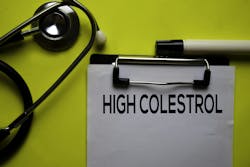More than 70% of American Indian young adults aged 20-39 and 50% of American Indian teens have cholesterol levels or elevated fat in the blood that put them at risk for cardiovascular disease, suggests a study supported by the National Institutes of Health.
In some cases, these levels — specifically high low-density lipoprotein (LDL) cholesterol, often thought of as “bad cholesterol,” — were linked to plaque buildup and cardiovascular events, such as heart attack and stroke.
The findings, published in the Journal of the American Heart Association, came from a 19-year-review of the Strong Heart Family Study, part of the Strong Heart Study — the largest study of cardiovascular health outcomes and risk factors among American Indian adults. Researchers followed more than 1,400 participants, ages 15-39, between 2001-2003 and 2020. At the beginning of the study, 55% of participants ages 15-19 had abnormal cholesterol levels, as did 74% of those ages 20-29, and 78% of those ages 30-39.
The researchers defined a person’s cholesterol as abnormal if they had either high total cholesterol; high LDL cholesterol or other types of “bad” cholesterol; moderately high triglycerides; low HDL cholesterol, often thought of as “good cholesterol”; or if they had been prescribed cholesterol-lowering medication.
About 40% of study participants had high LDL levels (at least 100 mg/dL), while nearly 3% had very high levels (at least 160 mg/dL). However, less than 2% of participants with very high LDL cholesterol took cholesterol-lowering medication at the start of the study.
Heart disease is twice as high in American Indian adults compared to the general U.S. population. Abnormal cholesterol levels seen among participants in the current study were also twice as high as abnormal levels seen in the general population of U.S. teens and young adults. Researchers underscored the value of routine check-ins and screenings. All participants in this observational study were also notified about their lab work and imaging results after their physical exam and researchers encouraged them to take the results to their healthcare providers.
At the start of the study, 1,165 participants had ultrasounds of the carotid artery, an artery in the neck that carries blood from the heart to the brain. Approximately 61 (5%) showed signs of plaque or early plaque development. Plaque can prohibit blood flow to the heart or rupture when too much of it accumulates in an artery, and that can lead to a stroke or need for surgery.
About 5.5 years after the baseline measurements, 19 participants — about one-third of those with detectable plaque — had signs of their plaque getting worse. Among the 1,104 who did not have detectable plaque at the beginning, 109 (10%) had signs of it during the second check-in. Researchers linked high levels of LDL cholesterol, total cholesterol, and other non-HDL cholesterol to these outcomes.
By the end of the study, approximately 127 participants (9%) had experienced a heart attack, stroke, heart failure, or a related heart surgery or death. Participants who had diabetes and at least a few cardiovascular risks, such as having a large waistline, high blood sugar, high triglycerides, high blood pressure, or low levels of HDL cholesterol, were also more likely to have cardiovascular events.

